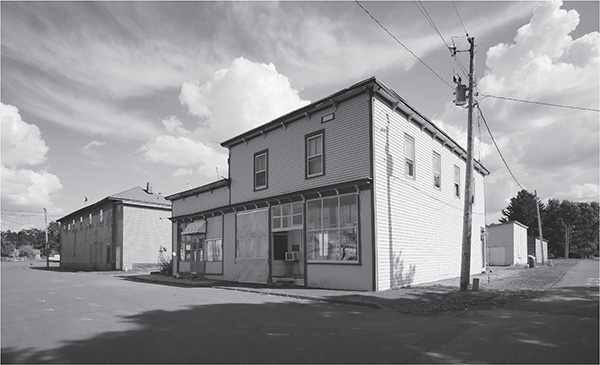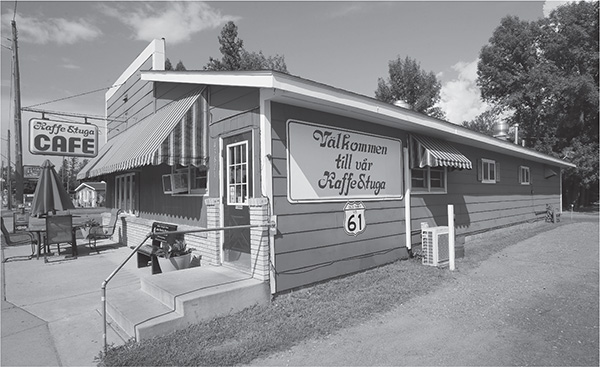
A set of railroad tracks runs through the heart of Harris, with Big Daddy’s in the background. Bill Klotz.
4
“A Hotel, a Livery and Several Stores”
Albin Johnson’s hometown of Harris, located in the heart of Chisago County, was first platted in 1873 and was incorporated as a village on July 22, 1884, according to a booklet published in 1984 on the occasion of the town’s centennial celebration. The 128-page booklet informs readers that a fellow named Fred Wolf was responsible for a number of firsts in the fledgling village. He was the first settler, the first merchant and the first railroad agent, the publication notes. Perhaps the town should have been called “Wolf, Minnesota.” Instead, it was named after Phillip Harris, who is described in the Harris history publication as a “prominent officer of the St. Paul and Duluth railroad.” Harris was destined to become a big railroad town.
Those long silver rails came in handy for transporting potatoes, which figured prominently in the village’s economy for the first fifty years or so of its existence. Even before the railroad cut through the town, “farmers from near Princeton as well as Cambridge and Grandee brought their potatoes to Harris. It is said that one day, at its marketing height, over 400 loads of potatoes were unloaded,” according to the history booklet. In his 1958 book, Looking Back Over One Hundred Years in Northern Chisago County, Carl H. Sommer describes Harris as the “Potato Capital of Minnesota.” “Before the railroad came through Cambridge, most of the potatoes from that section found their way to Harris,” Sommer writes. “At times a whole train was made up with potatoes from Harris. The potato buyers from St. Louis and Chicago made their headquarters in Harris.” (Harris also fielded a pretty good baseball team back in the day. But, like Big Hank Johnson after a few too many beers, the games sometimes turned ugly. “I enjoyed many a game against them,” Sommer writes, “though many times the game ended in quite an argument.”)
By the 1930s, the potato market started to dry up. As the Harris centennial publication notes, “It became more difficult to get good seed, and even with good seed the acreage production was low. Mother Earth had been ‘potatoed out.’”
But the town didn’t hitch its wagon exclusively to potatoes. Other big cash crops coming and going through Harris included soybeans and corn. Also in its early days, the upstart town boasted “four stores, two hotels, three elevators, three hay presses, two blacksmith shops, a skating rink, an agricultural warehouse, livery stable, two saloons, a meat market, and a depot,” the booklet notes. Alfred P. Stolberg and A.O. Stark were among the town’s “early merchants and professional men,” according to Sommer’s book. Both would become prominent figures in the Albin Johnson case.
As of the 2010 census, Harris was home to 1,132 people—good, hospitable, salt-of-the-earth folks, by most appearances. Like so many other sleepy towns across the nation, it has bits and pieces of Americana on display in front of the town’s working-class homes. Red, white and blue flags dance in the breeze, while campers and fishing boats stand ready for a trip up north. The town is divided by a set of well-worn, rusty railroad tracks. Folks can truthfully say they grew up on the right or wrong side of the tracks, though it’s not immediately clear which is which.
Establishments and attractions along the main drag include a flea market, a bait shop, a post office and a cemetery. There’s also a Little League baseball field, a gas station, a storage place and an auto body shop. A Cars R Us business looks out across the street from the obligatory Welcome to Harris sign.
The main street coming into town from Interstate 35 is Stark Road, named after the family of A.O. Stark, the coroner who investigated the Albin Johnson case. The ballfield also bears Stark’s name, as do a number of gravestones in the idyllic Covenant Cemetery on the edge of town.
Among the locals is Nan Hult, a silver-haired grandmother with a sharp, curious mind and boundless energy. She lives with her husband, Ron, and the family’s cat, Conrad, in nearby North Branch. Swedish and American flags in the home’s front yard wave at visitors as they make their way to the front door, which is near a neat and tidy garage where Ron tinkers with his latest woodworking project. A resident of the area since the mid-1960s, Nan Hult dove headfirst into researching the Harris fire mystery. Her real name is Nancy Hult, but she may well be called Nancy Drew in a nod to her talent as an amateur sleuth.

A set of railroad tracks runs through the heart of Harris, with Big Daddy’s in the background. Bill Klotz.
During a spring 2017 drive down the main drag of Harris, Hult pointed out the now-shuttered Big Daddy’s Bar and Grill. The Big Daddy’s building once housed a dance hall on the upper floor and a restaurant down below, she said. Hult heard reports that the bodies of Alvira and her seven children were taken to the dance hall at the future Big Daddy’s building, where they were identified by Clayton Anderson, a now-deceased local who was wise to the ways of Harris.
Hult first heard about the Johnson tragedy in the early 2000s, when she and Ron had Anderson over for supper. She “was totally shocked by the horrible tragedy” and started to “delve into it,” she says. Anderson “seemed surprised that we hadn’t heard about it,” Hult added. “He then went on to tell us about it, as he was called by the coroner to come to the dance hall in Harris, where the remains were taken, to be a witness of the handling of the remains.”
Another resident from way back, Greg Strom, believes the bodies were brought to the hardware store behind the future Big Daddy’s. The store was owned in part by A.O. Stark, who was also the deputy county coroner and a mortician.

Some locals say the remains of Alvira and her children were brought to this former hardware store, pictured on the right behind Big Daddy’s. Bill Klotz.
Back in the 1930s, the hardware store doubled as a makeshift morgue, Strom said. In those days, besides selling nuts and bolts, the hardware store proprietor embalmed bodies and made caskets. These days, Big Daddy’s seems like the kind of place that would draw a good crowd when the Minnesota Vikings clash with the Green Bay Packers. The area is somewhat divided in its loyalties to the professional football archrivals, just as it was split down the middle decades ago in the aftermath of the Johnson fire. It’s not clear if the name Albin Johnson rang a bell to Big Daddy, but at least one other business in town is well aware of the strange saga of the fugitive farmer.
The Happily Ever After tattoo parlor and the Harris Country Charm Mercantile Shop flank the Kaffe Stuga, a quaint Swedish-themed diner that boasts a steaming hot cup of coffee and a smorgasbord of delicious comfort food. The diner uses Swedish-language signs to let customers know if the place is open (Vi är öppna) or closed (Tyvärr, vi är stängda). Locals simply call it “the Stuga.” A lot of old-timers hang out there for coffee, bright and early in the morning. On a wall of the Stuga, just to the left of the entry, is a wanted poster from the Pinkerton Detective Agency. The poster offers a fifty-dollar reward for information leading to the arrest of Albin Johnson. Fifty bucks was good money in 1933, but nobody was able to claim the booty. It’s too late in any case: the offer expired on December 31, 1933.

The Kaffe Stuga is a popular hangout in Harris. Albin Johnson’s wanted poster is on display. Bill Klotz.
Still, the publicity generated some fascinating leads. During the first couple of months after the fire, people from multiple states and Canadian provinces claimed to have spotted the missing big man. Albin Johnson findings popped up in Minneapolis, North Dakota, Montana, Pennsylvania, Saskatchewan and Manitoba, among other far-flung locations. One of those false alarms happened in southeast Minneapolis. The Minneapolis Star reported on April 27 that Minneapolis police were advised to follow up on a tip that someone bearing resemblance to Johnson had been seen four days earlier in that part of town. Perhaps some of those sightings were hoaxes. Maybe some folks just wanted to get their name in the paper or bask in their fifteen minutes of fame. Others appeared to be good-faith reports from responsible, civic-minded citizens who honestly thought they had seen the missing farmer and wanted to do their part to bring him to justice.
Following up on all leads, the Pinkertons joined the Royal Canadian Mounted Police in searching for Johnson north of the border. Though the agency must have appreciated the tips generated by news coverage of the case, the Pinkertons weren’t happy about some information that was fed to the press. That includes bold statements from Albin’s brother-in-law Harry A. Galpin, who contended, among other things, that fragments of Albin’s bones were indeed found in the ruins of the home.
F.C. Pennington, superintendent of the St. Paul branch of the Pinkerton National Detective Agency, said in a statement to the Winnipeg Free Press in early May that Galpin’s theories were “handicapping our hunt, since Canadian police naturally would be inclined to let up in their search if they believe such reports are true.” Pennington added, “The Canadian police have cooperated splendidly and inasmuch as we intend to continue our hunt in the Canadian provinces we are anxious to halt the circulation of erroneous reports,” as quoted by the Free Press. Pennington also told the newspaper that three physicians testified at the inquest and that additional examinations of the evidence showed there was no reason to believe that Albin died in the fire.
The Pinkerton agency, incidentally, has come a long way since those wanted poster days. Now based out of an eleven-thousand-square-foot office in Ann Arbor, Michigan, the company is still going strong with one hundred corporate offices worldwide, according to its website. But these days, instead of tracking down train robbers and the Albin Johnsons of the world, the company serves its clients with everything from employment screening to “security risk management.” According to its corporate website, the Pinkerton Detective Agency was founded in 1850 by Allan Pinkerton, a Glasgow, Scotland native who made his way to the United States in 1842. Five years later, he joined the Chicago Police Department. After rising to the position of police chief, he hung out a shingle of his own, opening his first private detective office at 80 Washington Street in the Windy City. Throughout the 1850s, the company says, the Pinkerton agency worked with police departments to “arrest criminals anywhere in the country.” The agency’s reputation soared in 1861, when it uncovered a plot to assassinate President Abraham Lincoln. During the Civil War, Pinkerton headed up the Union Intelligence, from which the U.S. Secret Service was born. In the 1870s, the agency’s website boasts, Pinkerton and his agents became “legendary” while in “relentless pursuit” of Jesse James, the Younger Gang, the Dalton Brothers and Butch Cassidy’s Wild Bunch. In 1899, the Pinkertons managed to “disband” the Wild Bunch.
But the Pinkertons, for all their guile and experience, were no match for Albin Johnson. “Grandma wanted to find him.…She contacted them [the Pinkertons]. But they never found him. That was just money lost, paying them for nothing,” said Jeanette Johnson, Alvira’s niece.